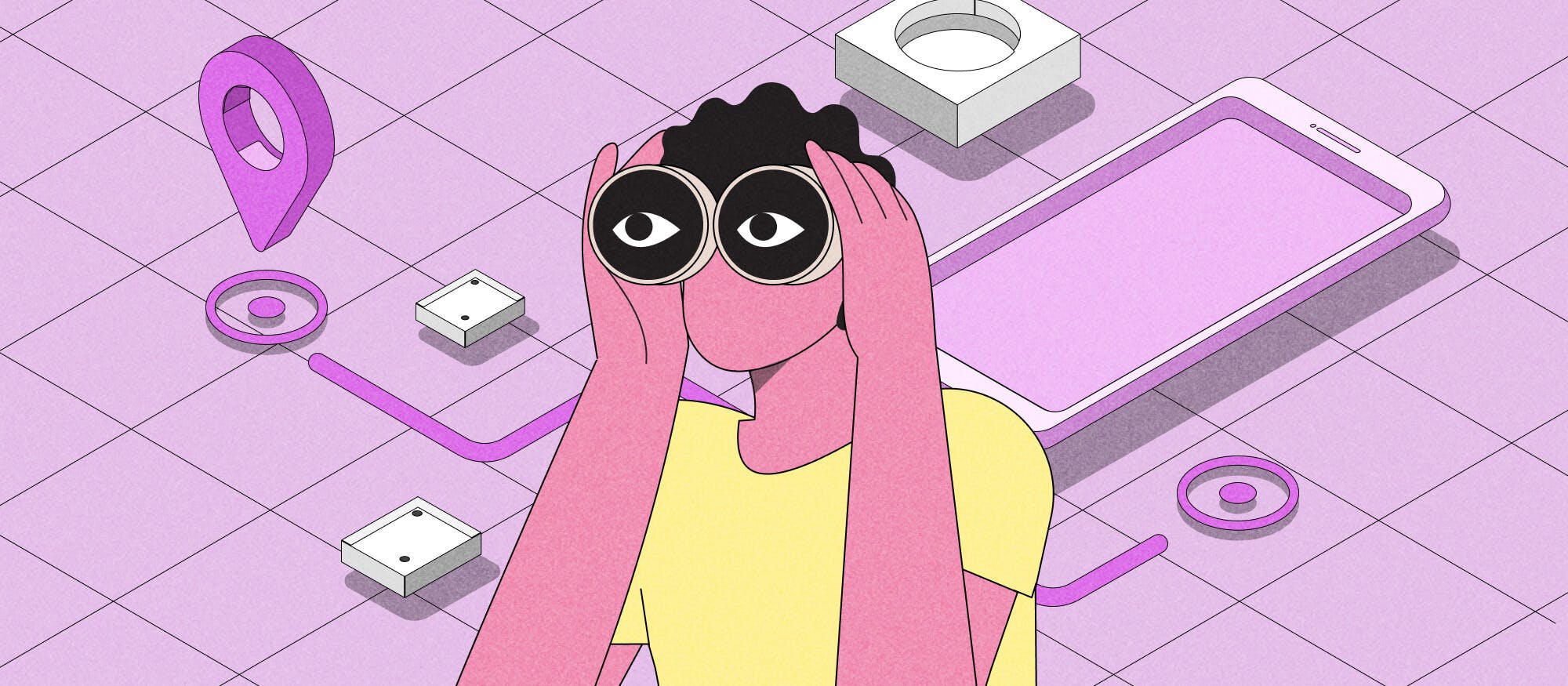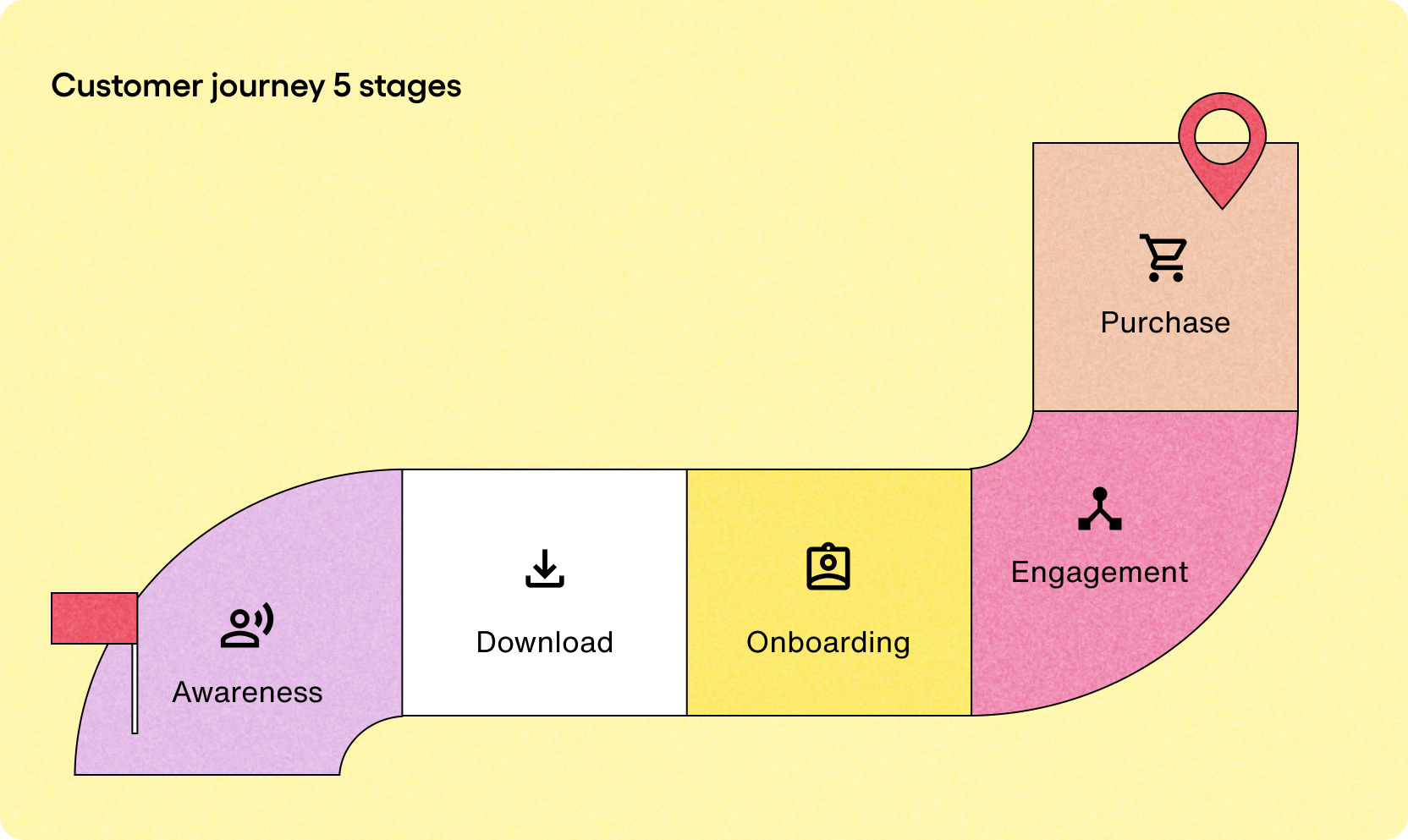Understanding the mobile app customer journey

Understanding every user’s experience at each step of the mobile app user journey is critical to driving engagement, retention, and conversion. Knowing why users have installed your app and how they will benefit means you can better meet their needs.
In this blog, we’ll cover all things related to the mobile app journey; including how to map the user journey, core journey elements every marketer should consider, an example of a customer journey from a mobile game to help you bring it all together.
What does your mobile app customer journey look like?
The user journey generally outlines how users complete a desired action, which usually includes making a purchase or reaching a goal.
Your mobile app customer journey looks like the path everyone takes on the way to that goal. For dating apps, the action could be purchasing unlimited swipes. Food delivery apps, purchasing a subscription to bring delivery costs down. Gaming apps, upgrading your gameplay with an in-app purchase.
The app user journey includes a flow chart of touchpoints and the user's actions, from downloading to conversion. You can also present your specific journey as an infographic to visualize the steps users take to complete each action (find an example of this below).
How can mapping the user journey help improve app performance?
By visualizing and building out your user journey, you can gain valuable insights into optimizing the customer experience and eliminating pain points wherever they exist. This exercise allows everyone to put themselves in the customer’s shoes to increase engagement and conversion.
For example, if users are churning too early on in the journey, take steps to shorten it. Make sure there aren’t any friction points, and add personalized messaging to help shortcut any search time on your customer’s end.
Boosting conversion and driving retention is the name of the game. Mapping your journey helps everyone in your org understand the critical aspects of your app and how customers navigate there.
Mapping your user journey also helps develop your UX, for apparent reasons. Here are some relevant UX resources from our team to yours:
The five stages of the mobile app user journey

The tricky part about mastering the mobile app user journey is that if you want people to download and engage with your app, you need to know what they need before realizing they need to do something.
That means you need to understand the problem driving their need, how they feel, and how they learn about your app as a solution. With this information in mind, you can then increase the chance they will download your app to meet their needs.
User engagement depends on what users think and feel as they encounter each step in the user journey. You need to know if your UX design and messaging encourage them to stay engaged with your app or if some element of the user experience frustrates them. It’s crucial for users to feel engaged and positive about your app at every touchpoint so they continue to the next stage of their journey.
The stages can vary depending on your app’s purpose and monetization goals. For example, the user journey for an ad-supported free game might focus on engaging users in the game to show them ads. In contrast, a trial version of a photo editing app might focus on engaging users so they buy a full version or subscription.
While every user's journey may differ, most apps share these common stages in their user journey:
1. App discovery and awareness
To start, your app must stand out among the millions of other apps on the Google Play Store and iOS App Store.
App store optimization, i.e., investing in early marketing funnel activities like app story copy and advertising, can help raise awareness around who you are, what you do, and where to find you.
2. App download
The first conversion point is when a user downloads and opens your app after finding it. If they like the app, they may continue on to create an account.
Competition is fierce, and the stakes for failure are high. The day one retention rate for new apps is 25.3%. Your app needs to make an excellent first impression so users stay engaged and continue to use it after downloading it. That means optimization: Ensuring the app is targeted to the right users, meets their needs immediately, and provides a seamless and engaging experience.
Get it right; users will sign up and enter your onboarding process.
3. App onboarding
The onboarding process must be intuitive enough to show users what to do and how to complete actions without adding friction.
A smooth and seamless onboarding experience will introduce the UX, explain features, build trust (and get necessary permissions like location sharing and permission to send push notifications), and make users familiar with and comfortable using your app.
When done right, onboarding should show users everything they can do with the app and build long-term retention and engagement.
4. Engagement and re-engagement
In this stage, user adoption and retention are crucial for your app’s success. This involves encouraging users to use key features, increasing active users daily, weekly, and monthly, and fostering app loyalty.
Since the 30-day retention rate for mobile apps is only 5.7%, building user engagement and reducing churn is essential. One effective way to achieve this is by using in-app messaging solutions. These can boost user engagement, provide instant customer support, and create a vibrant community for your app.
5. Purchase, action, and monetization
In-app purchases are the second key conversion point in the mobile app customer journey. For example, for a ride-sharing app, this point occurs when a user requests a pickup, or in a mobile game, it’s when a player buys a loot box or subscription.
In-app purchases can also take other forms depending on the app monetization model. Freemium games may focus on revenue from in-app advertising, so their end goal is long-term user loyalty and retention to increase the ad audience and earned revenue.
This stage can be challenging, as users may churn when faced with a purchasing decision. For example, users may search for an app offering the same features for free or become frustrated by too many in-app ads and delete their app. Building user engagement can help offset churn – highly engaged users are likelier to make in-app purchases.
Core elements of the app user journey
Whatever the steps of your unique user journey may be, there are a handful of elements that every builder and marketer needs to consider when creating an app with the perfect user flow:
Sign-up and login
The sign-up includes creating a user account in your app and successfully logging in.
Because it often requires providing personal information, it can also cause users to abandon the app. Make the sign-up process simple, transparent, and easy to understand to minimize the chance of users getting frustrated.
UX
User experience is fundamental to how people interact and react to your app. In general, providing a good UX means creating an intuitive, easy-to-use, and understandable app.
Ensure that elements such as in-app chat, overall look and feel, usability, and reliability are well-designed and let users do what they set out to achieve with your app. Functional bugs and glitches, a clunky interface, or an outdated design can result in users leaving the app.
Transaction and payment
Few things frustrate users more than a negative payment experience. Transactions within your app should be seamless and flexible. For example, users may want to use different payment methods or channels to make a transaction. If the payment process has friction points or doesn’t inspire trust, users may abandon the transaction (and the app) without purchasing.
Your user journey map must understand and consider the various handoffs and possible hiccups affecting the payment process to ensure a seamless user experience. Ensure that your payment methods are clear and straightforward and that essential communications such as order confirmations, pricing, and in-app messaging are informative and timely so users feel comfortable purchasing.
Personalization
Users increasingly demand personalized experiences, and smart mobile app marketers are taking notice. According to research by Google, 89% of marketers reported that app personalization increased their revenue.
To create user journeys that accurately reflect the experiences of real users, it is essential to gather data on user behaviors, perspectives, steps, thoughts, feelings, wants, and needs. This data lets you build features and design your app to provide the personalization users want. That means focusing on several key areas:
Personas
Create user personas based on common behavior to understand how different users interact with your app so you can optimize the user experience. Use research, analytics, and surveys to gather feedback and synthesize it into personas, including demographics, attitudes, and interests. Interest-based targeting is also important to tailor content and UX to user preferences.
Engagement style
How users engage with your app should inform the in-app messaging and UX experience to guide them along the user journey.
For example, understanding when users last engaged with the app and for how long lets you respond with special offers or messages to encourage them to re-engage. The more data you can collect on user engagement styles, the more you can refine your app to increase long-term engagement and reduce churn.
Messaging
Personalized and relevant in-app messaging creates a more positive user experience, which builds loyalty and retention. Use personas and user data to transform customer communication into ongoing, focused messaging conversations to inspire confidence and trust.
Location
Using location data can significantly enhance the functionality and personalization of your app. For example, you can provide localized and personalized content like recommendations and relevant updates to engage with users at any time and place.
Mobile app user journey example
Let's look at how all this comes together in a sample user journey for the mobile RPG/strategy game Heroes of Neverdale:
Discovery and installation: Users find the game on the app store or via ads and install it on their device.
Initial launch: Users are greeted with an animated splash screen on the first launch.
Onboarding: An automatic tutorial guides users through game mechanics like character movement, combat, and story progression.
Gameplay introduction: After the tutorial, users are introduced to different game modes, like PvE campaign and PvP arena.
Character customization: Users can create and customize their characters with unique appearances, skills, and weapons.
PvE campaign: Users engage in story-based missions and strategic challenges.
Social interaction: Users can join guilds, collaborate with other players, trade items, and communicate via chats.
PvP arena: Users can participate in PvP battles and compare their skills with players worldwide in a competitive ranking system.
In-game store: Users can buy in-game currency to enhance gameplay, with premium currency also available for purchase with real money.
Engagement mechanics: Daily missions, weekly challenges, and surprise content maintain user engagement and excitement.
Game updates: Regular content and feature enhancements are based on user feedback.
Community support: An in-game reporting mechanism is provided along with a dedicated community section with forums and developer logs.
Empower your mobile customer journey with Sendbird
With Sendbird, effective, easy-to-integrate, and customizable mobile user engagement is at your fingertips with our in-app user communications solutions.
Sign up to try Sendbird’s customer service software for free, or request a demo. Sendbird is ready to supercharge your app so you can deploy customer journeys that generate better engagement, conversions, and retention.










